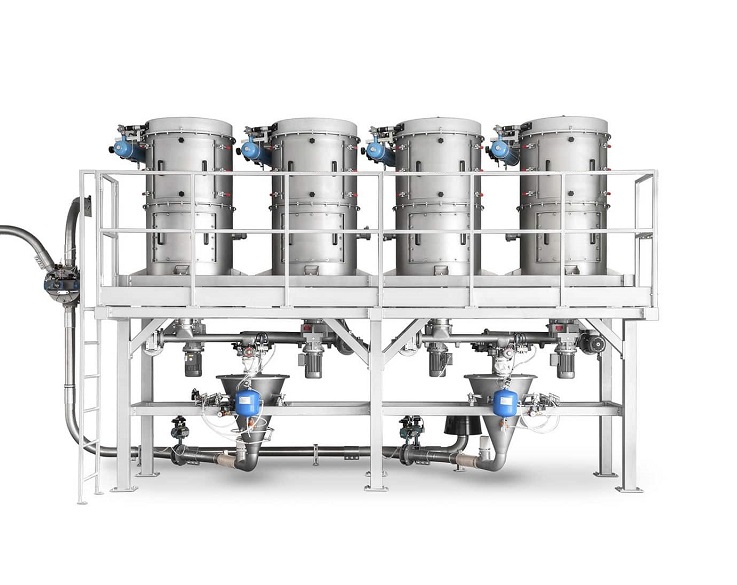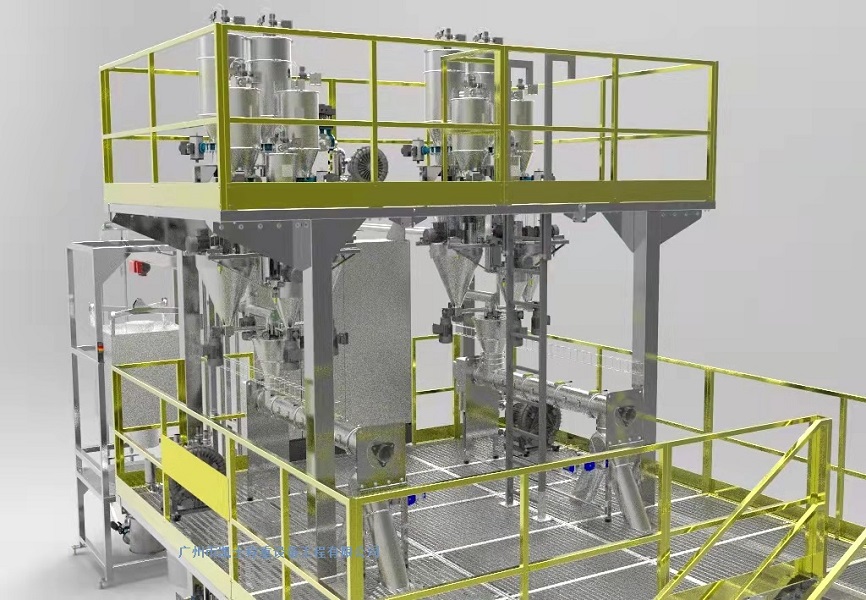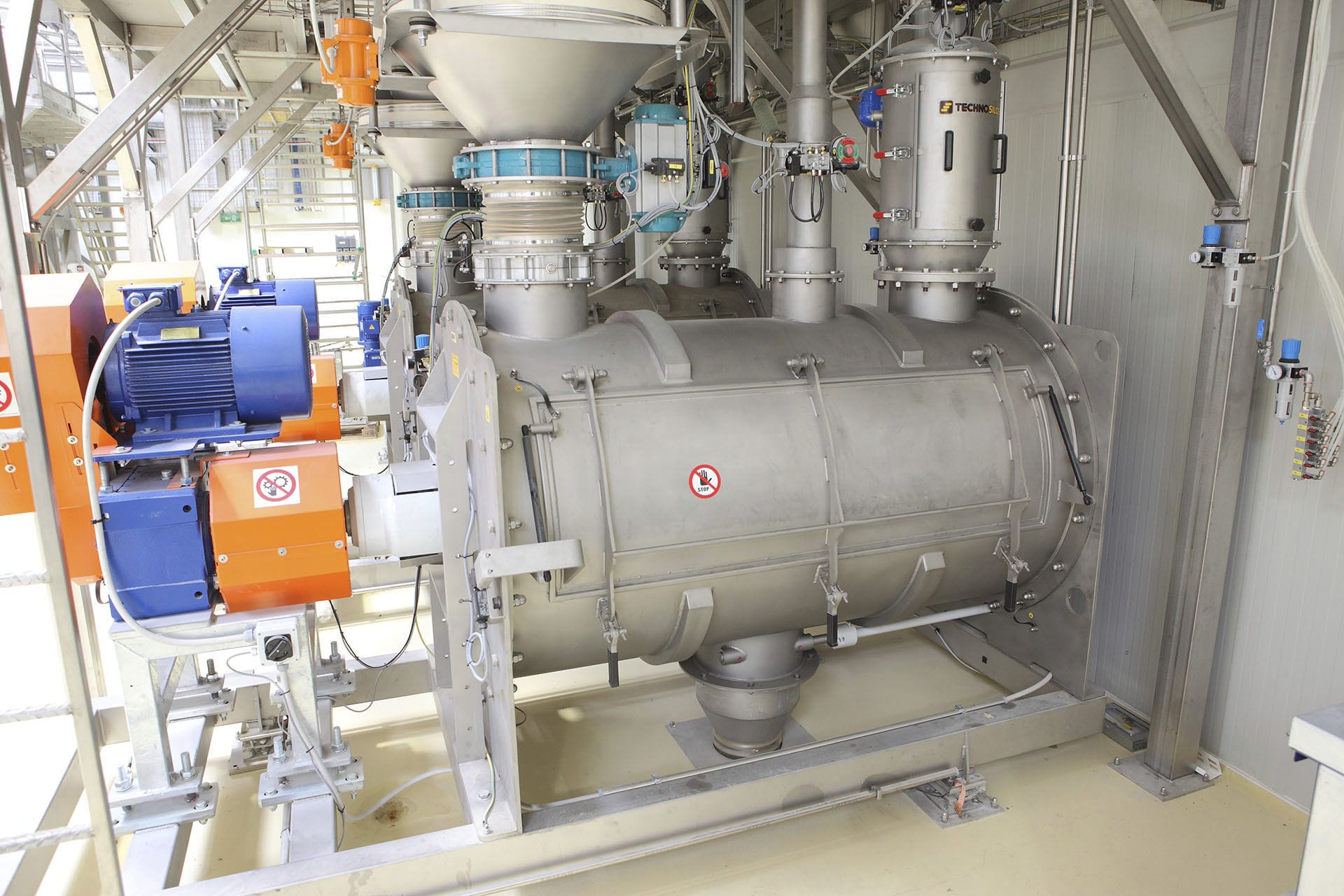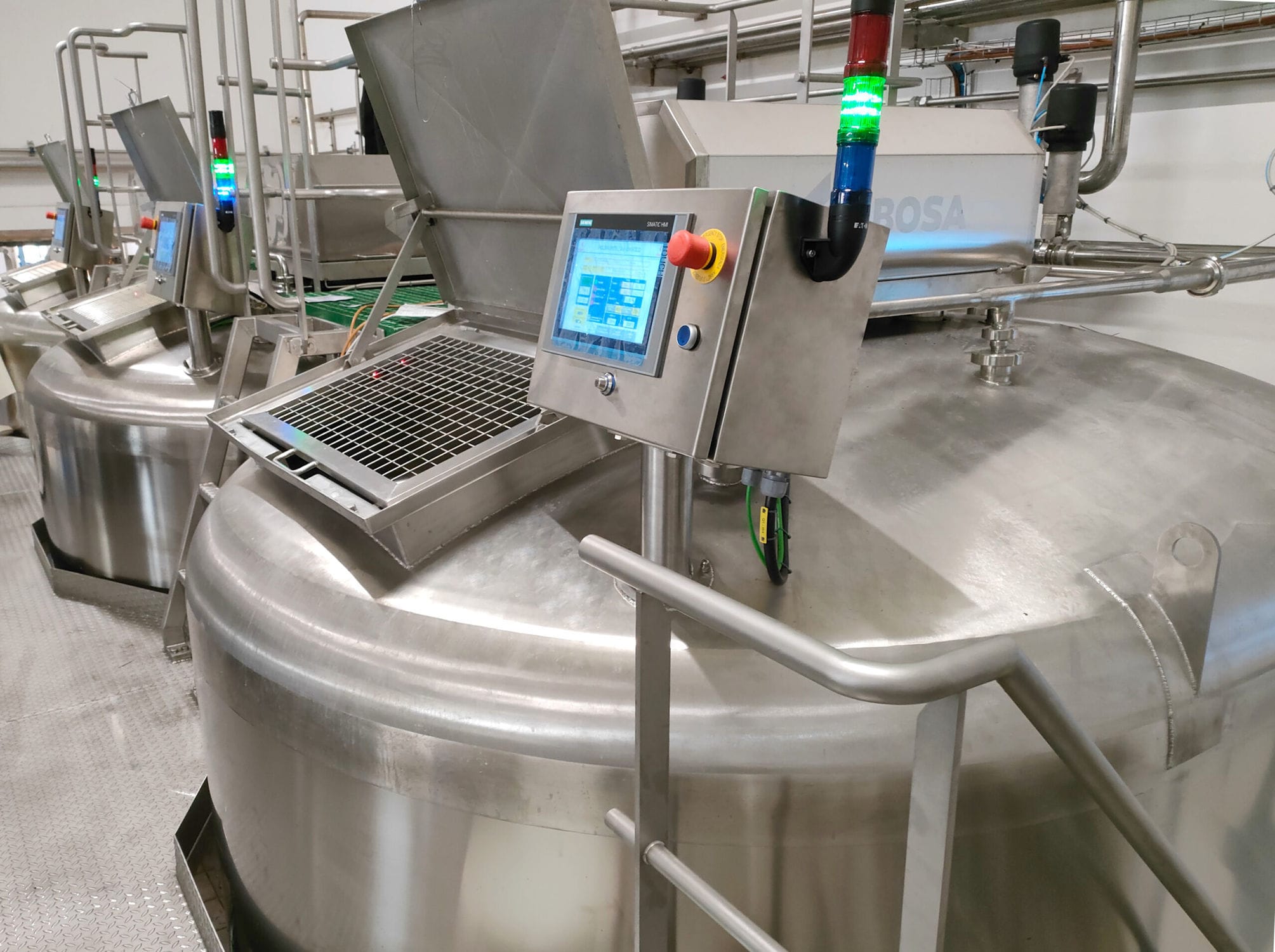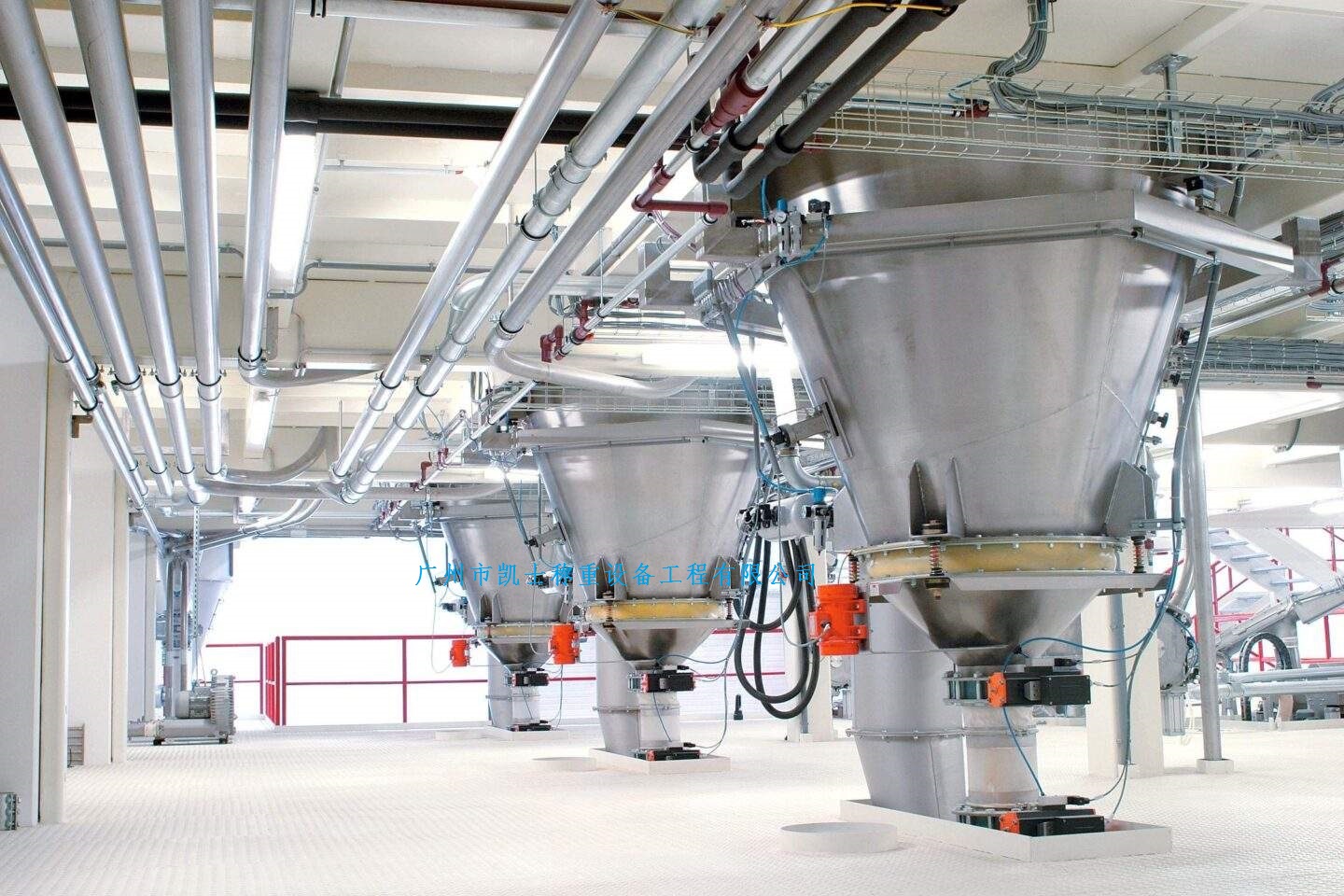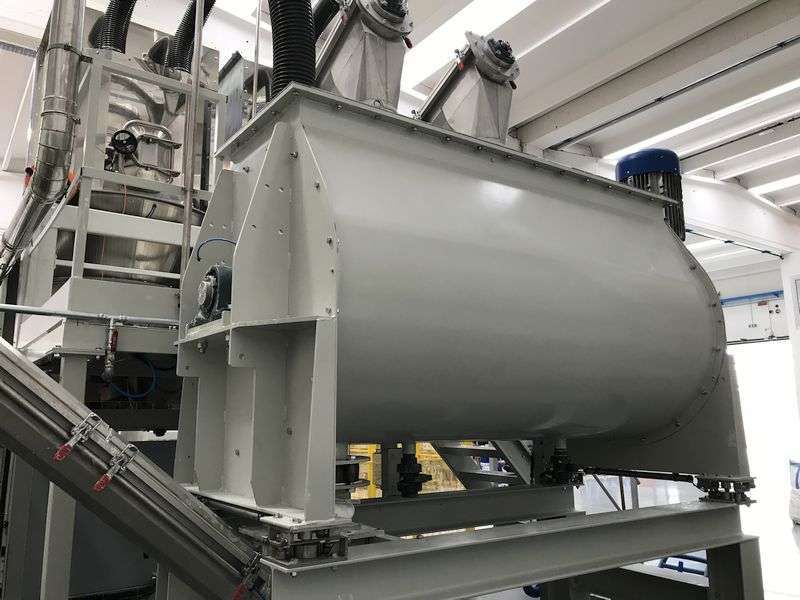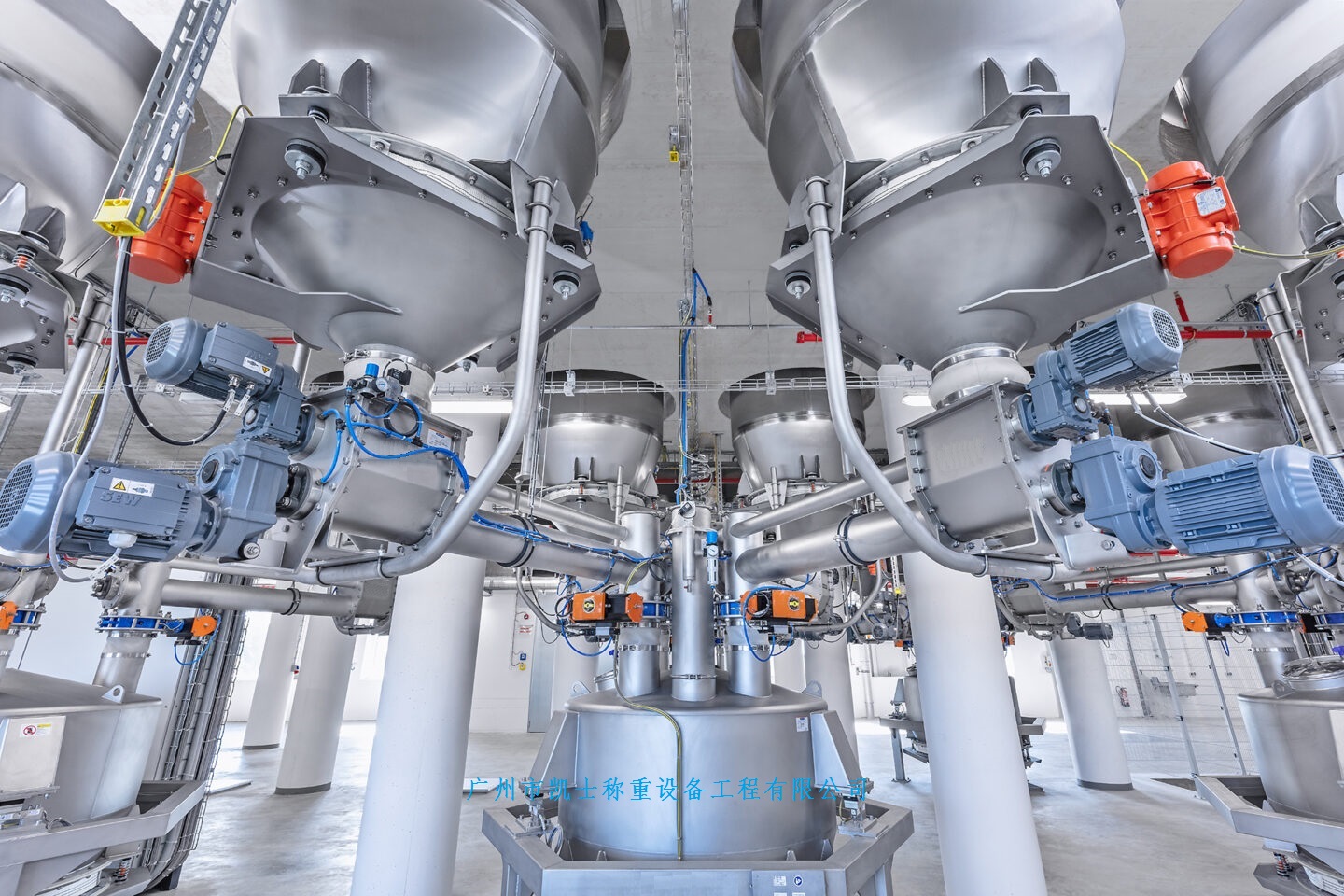

 2025.05.05
2025.05.05Summary:The automatic batching system is a closed system with pressure, with nitrogen as the conveying gas and powder as the conveying material. Materials enter the hopper D-1A/B from the upstream section, and enter the conveying pipeline through the rotary feeder RF-1A/B below the hopper. The power of the system is provided by the compressor C-1A/B, and the nitrogen pressurized by the compressor sends the materials in the pipeline under the rotary valve to the target silo D-2A/B to complete the conveying task.
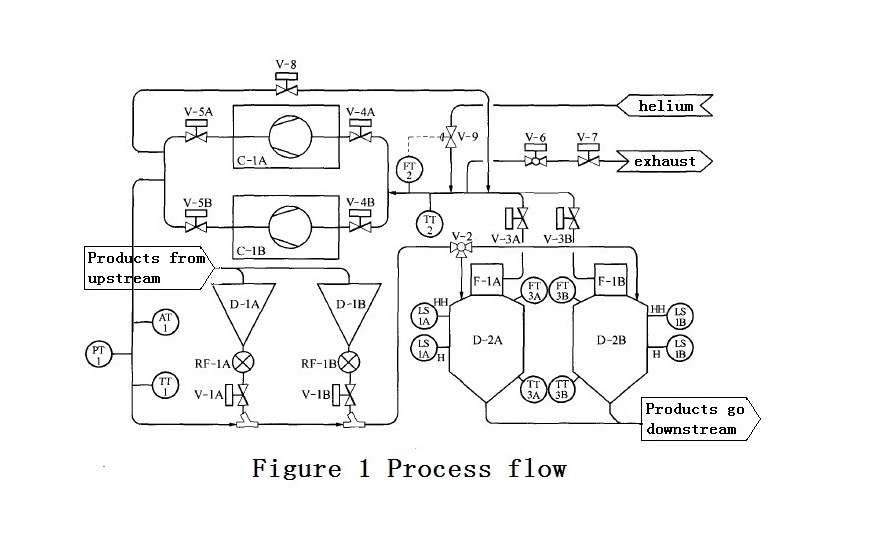
1 Problems raised
Pneumatic conveying engineering technology is a comprehensive technology, involving fluid mechanics, materials science, automation technology, manufacturing technology and other fields. Because it has the advantages of flexible arrangement, high efficiency and energy saving, adopting totally closed type pipeline conveying, no secondary pollution and high degree of automation, it is widely used in petroleum, chemical industry, metallurgy, building materials, grain and other departments, and is an advanced technology suitable for bulk material conveying. The conveying gas is usually air or nitrogen, and the power is usually provided by compressor or Roots blower. Pneumatic conveying system according to the different working pressure, can be divided into two categories of suction and pressure; according to the dense degree of particles in the conveying pipeline, that is, the solid gas ratio of the different, can be divided into two categories of sparse-phase and dense-phase conveying. Pneumatic conveying system has more dynamic equipment, high production continuity requirements, so the rationality, reliability and response speed of the control system plays a crucial role in the long cycle stability and safe operation of the whole pneumatic conveying system. In this paper, we will take the pressure-feeding rare-phase conveying system as an example, and discuss the automatic control system of pneumatic conveying in several aspects, such as the process flow, the main unit control of the system, the configuration and compilation of the system software as well as the system trial operation, combined with the actual engineering experience.
2 Brief description of the process flow
Figure 1 shows the process flow sketch of a typical pneumatic conveying system. The system is a pressurized closed system, with nitrogen as the conveying gas, and the material conveyed is powder. The material enters the charging hopper D-1A/B from the upstream section, and enters the conveying pipeline through the rotary feeder RF-1A/B below the hopper. The power of the system is provided by the compressor C-1A/B. The nitrogen gas pressurized by the compressor sends the material in the pipeline under the rotary valve to the target silo D-2A/B to complete the conveying task. The nitrogen is filtered through the filter F-1A/B on the upper part of the target silo and returned to the compressor inlet for recycling. The line where control valve V-9 is located is the nitrogen replenishment line, which is used to replenish nitrogen to the system at the beginning of startup or in case of insufficient nitrogen pressure. Valves V-6 and V-7 are located in the nitrogen discharge line. When the pressure in the system is too high, the nitrogen will be discharged into the atmosphere by opening these two valves to reduce the pressure in the system. As the compressor and rotary feeder are moving equipment, they have a certain failure rate and need regular maintenance, so these equipments are configured for one use and one backup.
The system is continuously, automatically and remotely operated under normal working conditions, so it is equipped with corresponding remote control valves and measuring instruments. The valves are mainly butterfly valves and three-way valves with cylinder actuators, and the remote control of the valves is realized through solenoid valves. Pressure transmitters (PT) and temperature transmitters (TT) are set up at the compressor outlet/inlet and the target silo for the measurement of pressure and temperature parameters. An oxygen analyzer (AT) is installed at the compressor outlet to detect the oxygen volume fraction in the system. Level switches (LS) are set at different heights on the target silo to realize the level alarm function.
The pneumatic conveying system can be roughly divided into three working conditions: system startup, system normal stop and system emergency stop. The following is a brief description of these three working conditions.
2.1 System startup
Before system startup, the entire system needs to be filled with nitrogen until the oxygen analyzer AT-1 indicates that the oxygen volume fraction is less than 4%. This process is usually done manually. Since the material being conveyed is a flammable medium, too high an oxygen content can cause the material to catch fire by friction in the pipeline. Once the oxygen content indicator is normal, the operator selects the conveying path on the operating station in the control room, i.e., selects the dosing hopper used, the rotary doser, the compressor and the target silo. After selection, the selected compressor inlet and outlet valves V-4A or B, V-5A or B are opened, the compressor bypass valve V-8 is opened, the valve below the rotary doser V-1A or B is opened, the three-way valve V-2 is pointed to the selected silo, and the nitrogen return valve V-3A or B is opened. All the above actions are done automatically by the program. Up to this point, the preparatory work for system startup has been completed, process operators in the operating station issued startup instructions, its startup steps: start the compressor; close the bypass valve, the system pre-purge for a certain period of time; start the rotary feeder, start conveying materials, system startup is complete.
2.2 System normal stop
Normal parking is issued by the process operator parking instructions, the parking steps: stop the rotary feeder; the system for a certain period of time to clear the blowing, will remain in the pipeline a small amount of material into the target silo; stop the compressor; open the bypass valve, the system parking is complete.
2.3 System emergency stop
Emergency stop is a kind of abnormal working condition, the system has an abnormal situation, such as temperature, pressure and oxygen volume fraction and other parameters exceed the standard, or the compressor itself fails. In this case, the first consideration is to protect the compressor and other important equipment safety. Therefore, once the emergency stop occurs, the system will automatically stop the compressor and rotary feeder at the same time, open the compressor bypass valve, so that the system is in a safe state.
3 The main unit control of the system
3.1 Nitrogen replenishment and emission control of the system
For the closed system, pressure is one of the most critical parameters, the effective control of pressure is related to whether the system can operate stably. The system shown in Figure 1 is to regulate the amount of nitrogen entering the system through valve V-9, and discharge the nitrogen to the atmosphere through valves V-6, V-7. V-9 is an ordinary control valve, V-7 is an ordinary butterfly valve, and V-6 is a special butterfly valve, which has a small hole in the center of the valve plate. The switching of these valves is utilized to control the compressor inlet pressure PT-1.PV.
Valve status monitoring function, ZSO/ZSC is the signal returned by the valve limit switch, FV-1A is the status variable of the valve, when FV-1A is 0, it means that the valve is operating in the correct state, and it can be opened and closed in place within the specified time, otherwise the valve fails. When the control system issued a valve open command, start timing, if the valve within T open limit switch return signal, indicating that the valve is open, for the FV-1A assigned 0; otherwise for the FV-1A assigned 1, the valve closure process is the same. If the valve is in a faulty state, the conveyor system will stop and the valve will need to be repaired and troubleshot. The logic for the compressor and rotary feeder is similar to that of the valve. It should be noted that T, T? is related to the type of equipment, the condition of the equipment and the requirements of the process, and can only be gradually adjusted to a suitable value through the actual operation and observation of the equipment. For monitoring the status of the bypass valve V-8 of the compressor, the valve is opened and closed at different times. v-8 is open, which means that the compressor is not loaded and is a relatively safe condition. In case of abnormal conditions, V-8 is opened first to protect the compressor, so V-8 needs to be opened very quickly. Closing V-8 at compressor startup allows the compressor to run with a load. If there is a pile of material in the pipeline, closing V-8 too quickly will cause the compressor load to rise sharply, resulting in high outlet pressure and interlocked stop. Therefore, V-8 is required to close at a relatively slow rate. In the valve status monitoring logic, to set different set values for T, T?
3.3 Compressor interlock protection
Compressor is the core equipment in the pneumatic conveying system, and its interlock protection is divided into two parts: compressor body interlock and process interlock.
Compressor body interlock is a compressor manufacturer with a field control panel, lubricating oil pressure, motor temperature and inlet and outlet pressure and other parameters to monitor, once these parameters exceed the standard, the control panel output a comprehensive fault signal, requiring the compressor to stop in a very short period of time, stopping the slow speed will likely cause damage to the compressor. Part of the DCSI / O point scanning speed in seconds, if the integrated fault signal sent to the DCS, after the logic operation and then sent to the motor control center (MCC) to stop the command, this process does not meet the requirements of immediate stop. Moreover, if the DCS fails to send a stop signal in time, the safety of the compressor will not be guaranteed. The most direct and effective way is to send the compressor integrated fault signal to the MCC, so that it becomes part of the compressor power supply control loop, the failure of the compressor power supply cut off synchronously, to achieve the purpose of immediate stop.
Compressor process interlock is the process of abnormalities and require the stopping of compressor operation. For the pneumatic conveying system mainly caused by the compressor interlocking reasons for stopping: compressor outlet and population valve closure; the selection of the conveyor path on the valve failure (described in the previous section); inlet pressure is too high or too low; outlet pressure is too high; the target silo pressure is too high; the system is too high in the volume fraction of oxygen.
3.4 Switching of the conveying path
The switching of the conveying path mainly includes the switching of the rotary feeder and the target silo, and here mainly explains the switching of the compressor in the operating state. Rotary feeder switching is relatively simple, as long as you stop the running rotary feeder, wait for a certain amount of blowing time, start another can be. Switching between target silos is divided into two modes: manual and automatic. In either mode, the rotary feeder should be stopped and purged for a certain amount of time before switching bins. In manual mode, after the purge is complete, select the new target bin, then start the rotary feeder and the switch is complete. In automatic mode, the process operator can pre-select a silo, and if the currently selected silo has a high material level alarm, the system can automatically switch to the pre-selected silo.
3.5 Fail-safe considerations
Fail-safe is to make the system in a relatively safe state when power failure, instrument wind failure and control system component failure occurs. In order to prevent instrument wind failure, the compressor outlet and inlet valves V-4A/B, V-5A/B, compressor bypass valve V-8, nitrogen return valve V-3A/B and other valves are required to be fault open AFO (AirFailOpen).
Normal operation of the rotary feeder and compressor is controlled by the control system to send open and stop commands to the MCC. in order to prevent damage to the instrumentation and control system caused by the strong voltage of the MCC, the signals related to the MCC are generally isolated by intermediate relays. According to the requirements of the compressor control circuit, the stop signal is required to be a positive pulse signal. Taking into account the need for fail-safe, in the design of the control system, the control system of the parking signal output for the negative pulse, corresponding to the output of the relay connected to the normally closed contact (this contact is closed when the coil is not charged) to the MCC. the advantage of such a design is that the relay in the compressor is running coil is charged, when the power supply fails, or the coil is damaged, the normally closed contact is closed, resulting in the compressor stop, of course! Compressor stop is a relatively safe state.
4 control system configuration and programming
The automatic control of pneumatic conveying system is a typical sequential control, and its control system can generally be realized by DCS or PLC. The following is an example of Honeywell's TPS decentralized control system to illustrate the realization of the pneumatic conveying control system to focus on several issues.
4.1 System point configuration
a) Digital Combination Point (DC). The DC point can be connected to 2 input and 2 output variables for operation of equipment such as valves, rotary feeders and compressors. The inputs are connected to the limit switch signals of the valves or the operating status signals of the moving equipment, and the outputs are connected to the command signals of the valves or the moving equipment. there are two operating states for the DC point: manual and program. When the DC point is placed in the manual state, it can be operated through the standard control panel that comes with the DCS to switch or start/stop the single device it corresponds to, this function is used for the single device debugging stage, the remote operation of the device is very convenient; when the DC point is placed in the program state, it can only be operated through the CL (ControlLanguage, a kind of high-level programming language that comes with the TPS system). Program or logic point for switching or start/stop operation, which is convenient for sequence control. Through the application of DC points, it is possible to realize the operation of valves and moving equipment in both manual/automatic states, which is convenient for system stand-alone commissioning and program control.
b) Flag quantity point (FLAG). FLAG has only two states: 0 and 1. FLAG can be used as an intermediate variable in the LOGIC point or CL program, or as an alarm register.
c) Logic point (LOGIC). Conventional logic operations such as with or without gates and RS triggers can be realized through LOGIC points. Compressor start, stop interlock, valve status monitoring and delivery path selection and switching and other logic functions can be realized through the LOGIC point. In addition, LOGIC points can also realize the alarm and interlock functions of analog signals.
d) Point in time (TIMER). There are many time variables in a pneumatic conveying system, such as system start-up pre-purge time, valve and moving equipment Watchdog, and system shutdown purge time, etc. These time variables can be controlled by TIMER points. These time variables can be controlled through the TIMER point, the set value of the TIMER point is the time to be controlled, through the manual or CL program can start the TIMER point timing, when the timing reaches the set time, the TIMER point of the state of the amount of flip-flop. When the time set is reached, the state of the TIMER point flips, and the desired action can be triggered by this state quantity.In the CL program, it is also possible to operate the time variable directly without using the TIMER point, but the use of the TIMER point facilitates the debugging of the system and the operation of the operator. Since the time variable may change according to different operating conditions, it can also be further optimized through the continuous accumulation of experience in process operation. The process operator can change the time variable by changing the time setting value of the TIMER point directly on the point's detail screen. Because modifying variables in the CL program requires recompiling and reloading the CL program, this is a complicated process that only DCS maintenance personnel can do, and process operators are not able or allowed to do it.
Other types of points, such as analog input/output points (AI/AO), digital input/output points (DI/DO) and PID control points (RC) are indispensable to any control system points, limited to space here will not be described.
4.2 Programming
The TPS system provides two tools, CL program and logic point, to implement the sequence control function. Combining CL program and logic point to realize the control function of pneumatic conveying system can improve the readability and maintainability of the control program as well as facilitate the process operation.
The selection of target silos, the selection of compressors and interlock protection, the selection of rotary feeders, the start interlock of the system, the stop interlock conditions and the emergency stop action are realized through the logic point configuration. In this way, the whole system is divided into several relatively independent sub-systems, each sub-system is controlled by a different logic point, while all the functions of the system on safety protection are realized by logic points. During the commissioning phase of the system, each subsystem can be commissioned individually without being affected by the other parts. The sequential start and stop steps of the system are realized by means of the CL program. Under special working conditions, if manual operation of the conveyor system is required, the CL program can be stopped and the operator can operate the system according to the required steps. Since the safety protection function is not realized by the CL program, this ensures the flexibility of the system operation without reducing the safety of the system.
Using this idea of combining CL programs and logic points, pay attention to the following two points when configuring and programming.
a) CL programs and logic points are organically combined through the passing of custom FLAG points. These FLAG points do not have any significance and only serve the purpose of variable passing. For this kind of FLAG point, only one logic point or CL program can perform the assignment operation, that is to say, if they are assigned a value in the program, the FLAG point cannot be used as the output of the logic point in the process of logic point configuration, and vice versa.
b) In the TPS system, the execution speed of the CL program is milliseconds, while the scanning cycle of the logic point is relatively longer. Therefore, during programming and configuration, it is important to take note of this characteristic and adopt certain techniques to synchronize the CL program and logic point operation. The following is a simple example to illustrate this problem.
5 System debugging and driving
5.1 Program offline debugging
On-site installation and construction is not yet completed before the control system can be offline debugging, so that you can check whether the group state is correct, logical relationships and sequence control to meet the requirements of the process. Offline debugging can be simulated on the DCS on-site signals to meet the conditions required for program operation.
5.2 Stand-alone commissioning
After the installation of on-site batching equipment, you can test the instrumentation, valves, rotary feeders and compressors and other equipment one by one. This stage can check whether the signal detected by the instrument is accurate, whether the valve is opened/closed within the specified time, whether the rotary feeder and compressor can be started and stopped correctly, and whether the interlock protection function of the compressor is correct.
5.3 System nitrogen test
Stand-alone debugging is completed, you can put all the programs and logic into the automatic state, without physical material for trial. This stage can further check the logic relationship and sequence control is correct, you can actually carry out the compressor, conveying path switching, the sequence of the system start and stop, as well as testing the emergency stop function.
5.4 System commissioning with real material
Because of the high risks associated with physical material commissioning, the first time is usually done manually. First the compressor is started manually. Before the startup, the operator will check whether the valves of the inlet and outlet are open on site as a precautionary measure. When the system pressure has stabilized, the bypass valve can be closed to allow the compressor to carry the load. Then manually start the rotary doser and open the discharge valve upstream of D-1A/B for material conveying. In the initial stage of conveying should be upstream discharge valve opening small, so that the compressor load should not be too large, to be stable after the system operation, and gradually increase the amount of material feeding until the system's design capacity. When the compressor outlet pressure reaches the design volume, it marks the success of pneumatic conveying system driving.
In the system trial stage, the time variables of the system should be adjusted according to the actual operating conditions, such as the system pre-purge time, the closing time of the bypass valve, and the switching time of the valve. These times will all affect the time required for sequential system start-up. If the time required for start-up is too long, it will result in a high material level in the upstream system of the pneumatic conveying system and a stop.
6 Conclusion
The pneumatic conveying system discussed in this paper is a simplified and abstracted simulation that includes only the most critical equipment and instrumentation necessary for a pneumatic conveying system. The actual system is more complex than this system, there will be many auxiliary facilities, such as heat exchangers, filters, manual valves, and rotary feeders and filters of nitrogen blowback control unit, etc., the silo and conveying path setup is relatively more complex. At the same time, according to the different conveying media and process flow, the control system will also have some differences. But the authors are introduced to the pneumatic conveying control system is the most basic implementation methods and ideas, as well as some of the skills summarized in the project, I hope that the actual engineering system design and implementation of some reference and help.


















